Sweet Corn Seeds Market
Sweet Corn Seeds Market Size and Share Forecast Outlook 2025 to 2035
Sweet corn seeds market is projected to grow from USD 1.8 billion in 2025 to USD 2.8 billion by 2035, at a CAGR of 4.5%. Hybrid will dominate with a 64.0% market share, while food will lead the end use segment with a 54.0% share.
Sweet Corn Seeds Market Forecast and Outlook 2025 to 2035
The sweet corn seeds market stands at the threshold of a decade-long expansion trajectory that promises to reshape agricultural biotechnology and crop production solutions. The market's journey from USD 1.8 billion in 2025 to USD 2.8 billion by 2035 represents substantial growth, the market will rise at a CAGR of 4.5% which demonstrating the accelerating adoption of advanced seed technology and agricultural optimization across farming operations, food production facilities, and global agricultural markets.
The first half of the decade (2025-2030) will witness the market climbing from USD 1.8 billion to approximately USD 2.2 billion, adding USD 0.4 billion in value, which constitutes 40% of the total forecast growth period. This phase will be characterized by the rapid adoption of hybrid seed systems, driven by increasing food demand and the growing need for enhanced crop yield solutions worldwide. Enhanced genetic traits and disease resistance capabilities will become standard expectations rather than premium options.
The latter half (2030-2035) will witness continued growth from USD 2.2 billion to USD 2.8 billion, representing an addition of USD 0.6 billion or 60% of the decade's expansion. This period will be defined by mass market penetration of advanced breeding technologies, integration with precision agriculture platforms, and seamless compatibility with existing farming infrastructure. The market trajectory signals fundamental shifts in how agricultural producers approach crop production optimization and yield management, with participants positioned to benefit from growing demand across multiple trait categories and end-use segments.
Quick Stats for Sweet Corn Seeds Market
- Sweet Corn Seeds Market Value (2025): USD 1.8 billion
- Sweet Corn Seeds Market Forecast Value (2035): USD 2.8 billion
- Sweet Corn Seeds Market Forecast CAGR: 4.5%
- Leading Trait Type in Sweet Corn Seeds Market: Hybrid
- Key Growth Regions in Sweet Corn Seeds Market: North America, Western Europe, and East Asia
- Top Key Players in Sweet Corn Seeds Market: Bayer, Corteva, Syngenta, Limagrain, Sakata
- Where revenue comes from - now vs next (industry-level view)
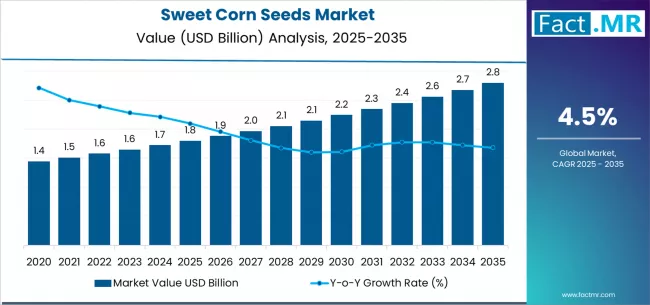
| Period | Primary Revenue Buckets | Share | Notes |
|---|---|---|---|
| Today | Hybrid seed varieties | 64% | Superior yield and uniformity focus |
| Open-pollinated varieties | 36% | Traditional and specialty applications | |
| Food-grade applications | 54% | Fresh market and processing | |
| Fodder/feed applications | 31% | Livestock feed markets | |
| Future (3-5 yrs) | Advanced hybrid varieties | 68-72% | Enhanced traits and climate resilience |
| Specialty food varieties | 58-62% | Premium and organic market segments | |
| Climate-adapted genetics | 15-20% | Drought and stress tolerance traits | |
| Direct-to-farmer sales | 25-30% | Digital platforms and precision agriculture | |
| Value-added services | 10-15% | Agronomic support and crop management |
Sweet Corn Seeds Market Key Takeaways
At-a-Glance Metrics
| Metric | Value |
|---|---|
| Market Value (2025) → | USD 1.8 billion |
| Market Forecast (2035) ↑ | USD 2.8 billion |
| Growth Rate ★ | 4.5% CAGR |
| Leading Trait Type → | Hybrid |
| Primary End Use → | Food |
The market demonstrates strong fundamentals with hybrid seeds capturing a dominant 64% share through advanced breeding capabilities and yield optimization. Food applications drive primary demand at 54%, supported by increasing consumption patterns and agricultural productivity preferences for enhanced yield solutions. Geographic expansion remains concentrated in developed markets with established agricultural infrastructure, while emerging economies show accelerating adoption rates driven by food security initiatives and agricultural modernization programs.
Imperatives for Stakeholders in Sweet Corn Seeds Market
Design for crop outcomes, not just genetics
- Offer comprehensive agricultural packages: seed varieties + agronomic support + crop management + yield optimization + harvest guidance systems.
- Preconfigured farming workflows: planting protocols, fertilization programs, pest management, and harvest timing optimization systems.
Climate adaptation readiness
- Drought tolerance traits, heat resistance capabilities, and weather resilience technologies with sustainable agriculture integration.
Precision agriculture-by-default
- Digital farming compatibility, GPS integration, variable rate seeding, and comprehensive farm management system connectivity.
Farmer-focused solutions without complexity
- Clear variety selection + transparent performance data; agronomic support services and regional adaptation expertise.
Segmental Analysis
Primary Classification: The market segments by trait into hybrid and open-pollinated categories, representing the evolution from traditional farming methods to advanced agricultural biotechnology systems for diverse crop production optimization.
Secondary Classification: End use segmentation divides the market into food, fodder, and industrial/others sectors, reflecting distinct requirements for human consumption, animal feed, and specialized application standards.
Tertiary Classification: Distribution segmentation covers agri-retailers, cooperatives, and online/others channels, while agricultural areas span fresh market production, processing applications, livestock feed, and specialty farming programs.
Regional Classification: Geographic distribution covers North America, Western Europe, East Asia, and emerging markets, with developed regions leading adoption while developing economies show accelerating growth patterns driven by food security programs and agricultural development expansion.
The segmentation structure reveals seed evolution from traditional open-pollinated varieties toward advanced hybrid systems with enhanced productivity and specialized trait capabilities, while application diversity spans from direct consumption to livestock feed requiring precise agricultural performance and yield optimization solutions.
By Trait, the Hybrid Segment Accounts for Dominant Market Share
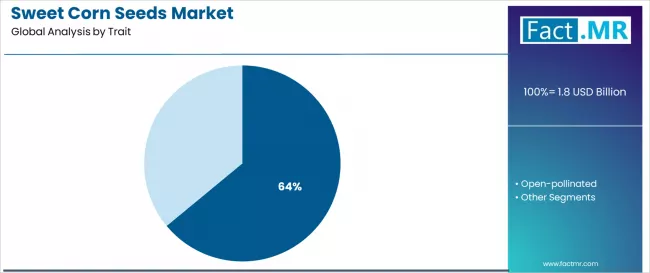
Market Position: Hybrid seed varieties command the leading position in the sweet corn seeds market with 64% market share through advanced breeding features, including superior yield potential, uniform crop characteristics, and agricultural productivity optimization that enable farmers to achieve optimal harvest outcomes across diverse growing conditions and agricultural environments.
Value Drivers: The segment benefits from farmer preference for reliable seed systems that provide consistent yield performance, improved crop uniformity, and agricultural efficiency optimization without requiring significant farming practice modifications. Advanced breeding features enable disease resistance, enhanced vigor, and integration with existing agricultural equipment, where yield performance and crop reliability represent critical farming requirements.
Competitive Advantages: Hybrid seed varieties differentiate through proven agricultural performance profiles, consistent yield characteristics, and integration with comprehensive farming systems that enhance agricultural effectiveness while maintaining optimal crop quality standards suitable for diverse food production and processing applications.
Key market characteristics:
- Advanced breeding designs with optimized genetic combinations and agricultural performance capabilities
- Superior yield effectiveness, enabling 15-25% yield increase with consistent crop performance
- Agricultural compatibility, including mechanization integration, input optimization, and farming system coordination for crop production applications
Open-Pollinated Shows Traditional Farming Growth
Open-pollinated seed varieties maintain a 36% market position in the sweet corn seeds market due to their specialized traditional properties and seed-saving advantages. These varieties appeal to farmers requiring heritage genetics with competitive performance for organic and specialty applications. Market growth is driven by sustainable agriculture expansion, emphasizing reliable traditional solutions and farm-saved seed through established open-pollinated systems.
By End Use, the Food Segment Shows Market Leadership
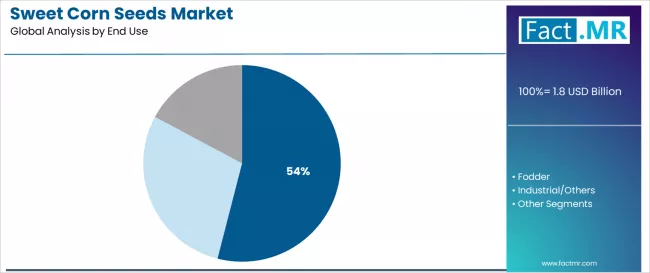
Market Context: Food applications demonstrate market leadership in the sweet corn seeds market with 54% share due to widespread adoption of fresh consumption varieties and increasing focus on food production, processing optimization, and nutritional value applications that maximize crop utilization while maintaining quality standards.
Appeal Factors: Food production operators prioritize crop quality, market acceptance, and integration with existing food processing infrastructure that enables coordinated production across multiple food market programs. The segment benefits from substantial consumer demand investment and food industry programs that emphasize the acquisition of advanced seed varieties for quality optimization and market positioning applications.
Growth Drivers: Food production programs incorporate sweet corn as standard components for crop rotation, while consumer demand growth increases requirements for quality varieties that comply with food safety standards and minimize production complexity.
Market Challenges: Varying consumer preferences and quality requirements may limit variety standardization across different markets or food processing applications.
Agricultural dynamics include:
- Strong growth in fresh market production requiring premium quality varieties
- Increasing adoption in food processing applications and value-addition programs
- Rising integration with food supply chain systems for quality optimization and traceability assurance
Fodder Applications Maintain Feed Market Demand
Fodder and feed applications capture 31% market share through specialized livestock nutrition requirements in dairy operations, beef production, and animal feed manufacturing programs. These applications demand reliable feed corn varieties capable of consistent nutritional content while providing effective livestock nutrition and production optimization.
Industrial/Others Applications Show Specialty Growth
Industrial and other applications account for 15% market share, including biofuel production, starch manufacturing, and specialized processing requiring advanced capabilities for industrial optimization and value-added processing.
By Distribution, the Agri-Retailers Segment Leads Market Access
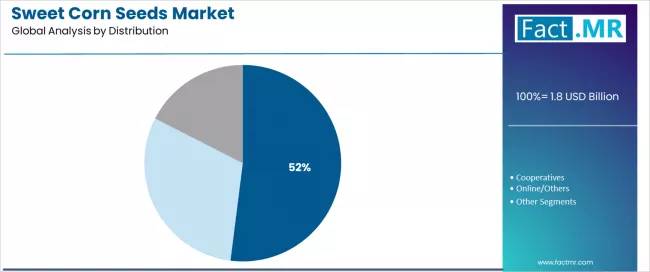
Market Position: Agricultural retailer channels command 52% market position with strong growth through optimal farmer access approach that balances product availability and technical support for diverse agricultural applications.
Value Drivers: This distribution segment provides the ideal combination of local presence and agronomic expertise, meeting requirements for seed selection, technical guidance, and regional adaptation without excessive complexity or accessibility barriers.
Growth Characteristics: The segment benefits from broad geographic coverage across agricultural markets, established farmer relationships, and comprehensive technical support that support widespread seed adoption and farming success.
What are the Drivers, Restraints, and Key Trends of the Sweet Corn Seeds Market?
| Category | Factor | Impact | Why It Matters |
|---|---|---|---|
| Driver | Food demand growth & population increase | ★★★★★ | Rising global food consumption drives demand for high-yielding crop varieties and agricultural productivity |
| Driver | Agricultural mechanization & precision farming adoption | ★★★★★ | Modern farming techniques require uniform crops; hybrid varieties provide consistency for mechanical harvesting |
| Driver | Climate change adaptation & resilient agriculture needs | ★★★★☆ | Weather variability increases demand for drought-tolerant and climate-adapted seed varieties |
| Restraint | High seed costs & farmer price sensitivity | ★★★★☆ | Premium hybrid seed prices create adoption barriers; farmer economics drive purchasing decisions |
| Restraint | Regulatory restrictions & GMO acceptance issues | ★★★☆☆ | Varying regional regulations on seed technology limit market access and product development |
| Trend | Organic and specialty variety expansion | ★★★★★ | Premium market segments demand specialty varieties; organic farming growth drives non-GMO seed demand |
| Trend | Digital agriculture integration & data-driven farming | ★★★★☆ | Precision agriculture platforms integrate seed selection with farm management systems and yield optimization |
Analysis of the Sweet Corn Seeds Market by Key Country
The sweet corn seeds market demonstrates varied regional dynamics with Growth Leaders including USA (4.8% growth rate) and Mexico (4.5% growth rate) driving expansion through agricultural innovation initiatives and crop production modernization. Steady Performers encompass Germany (4.1% growth rate), France (4.0% growth rate), and developed regions, benefiting from established agricultural systems and advanced farming technology adoption. Agricultural-Excellence Markets feature UK (3.9% growth rate) and Japan (3.7% growth rate), where farming expertise and crop optimization support consistent growth patterns.
Regional synthesis reveals North American markets leading adoption through agricultural technology advancement and crop productivity programs, while European countries maintain steady growth supported by sustainable agriculture initiatives and food security programs. Asian markets show diverse growth driven by food production expansion and agricultural modernization trends.
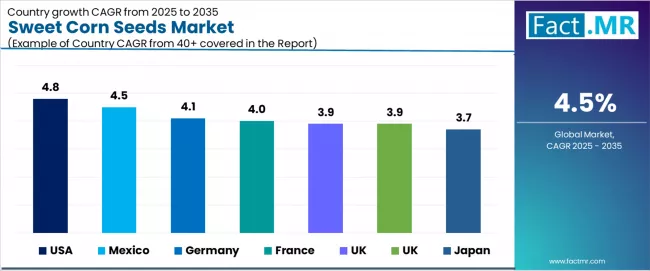
| Region/Country | 2025-2035 Growth | How to win | What to watch out |
|---|---|---|---|
| USA | 4.8% | Lead with innovation & yield | Climate challenges; input costs |
| Germany | 4.1% | Focus on sustainable varieties | Regulatory complexity; organic demand |
| UK | 3.9% | Leverage specialty markets | Brexit impacts; weather volatility |
| France | 4.0% | Emphasize quality genetics | CAP policy changes; environmental regulations |
| Japan | 3.7% | Develop precision varieties | Aging farmers; land constraints |
| South Korea | 3.9% | Build technology integration | Competition intensity; import dependence |
| Mexico | 4.5% | Expand smallholder access | Infrastructure limitations; climate variability |
USA Drives Market Leadership
USA establishes market leadership through comprehensive agricultural innovation programs and advanced seed technology development, integrating sweet corn seeds as standard components in crop production and agricultural modernization installations. The country's 4.8% growth rate reflects agricultural industry sophistication and farming productivity programs that mandate the availability of advanced seed varieties in crop production and agricultural technology facilities. Growth concentrates in major agricultural regions, including Iowa, Illinois, and Nebraska, where crop development showcases integrated agricultural systems that appeal to farmers seeking advanced yield capabilities and production optimization applications.
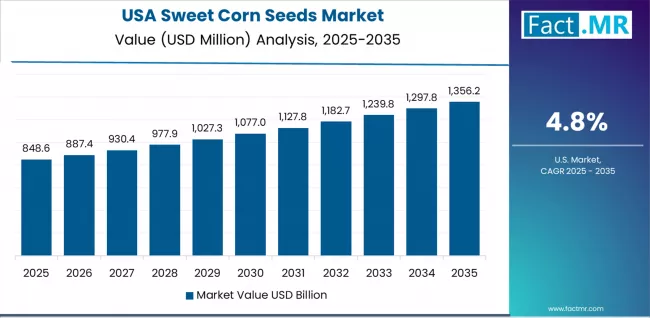
American seed companies are developing sophisticated sweet corn varieties that combine domestic breeding advantages with advanced genetic features, including climate adaptation systems and enhanced yield technologies. Distribution channels through agricultural retailers and cooperative systems expand market access, while farmer adoption supports utilization across diverse crop production segments and agricultural applications.
Strategic Market Indicators:
- Agricultural facilities leading adoption with 78% utilization rate in corn production and farming sectors
- Food demand programs providing substantial market demand for advanced seed technology advancement
- Local seed companies capturing 58% market share through innovation leadership and comprehensive agricultural offerings
- Export market development for advanced seed varieties targeting international agricultural markets
United Kingdom Shows Specialty Market Excellence
United Kingdom demonstrates market strength through specialty agricultural programs and sustainable farming initiatives, maintaining a 3.9% growth rate supported by premium crop production and environmental agriculture programs. The country leverages its established agricultural expertise and sustainable farming practices to drive sweet corn seed adoption across specialty farming and premium food production applications. Major agricultural regions in East Anglia, Yorkshire, and Scotland showcase advanced crop production capabilities that integrate with comprehensive sustainable agriculture services and premium food programs.
British market dynamics focus on specialty sweet corn varieties that balance agricultural performance with sustainability requirements important to UK farmers and food producers. The market benefits from sustainable agriculture initiatives supporting seed technology advancement and premium food partnerships that create sustained demand for quality-focused seed varieties in agricultural and food production applications.
Market Intelligence Brief:
- Specialty agriculture integration and premium food services leading growth with emphasis on quality production and sustainability optimization programs
- Agricultural sustainability partnerships driving innovative variety adoption and farming improvement programs
- Government agricultural initiatives supporting seed technology accessibility and sustainable farming programs
- Brexit considerations influencing seed supply chains and European agricultural alignment strategies
Germany Emerges as Sustainable Agriculture Leader
In Bavaria, Lower Saxony, and North Rhine-Westphalia, agricultural facilities and farming operations are implementing advanced sweet corn seeds as standard components for sustainable crop production and agricultural optimization applications, driven by increasing environmental agriculture initiatives and sustainability programs that emphasize the importance of ecological farming capabilities. The market holds a 4.1% growth rate, supported by sustainable agriculture initiatives and environmental farming development programs that promote eco-friendly seed systems for agricultural and environmental facilities. German farmers are adopting seed varieties that provide consistent agricultural performance and sustainability features, particularly appealing in regions where environmental compliance and agricultural quality represent critical farming requirements.
Market expansion benefits from established sustainable agriculture infrastructure capabilities and international seed technology partnerships that enable domestic integration of advanced seed systems for agricultural and environmental applications. Farmer adoption follows patterns established in sustainable agriculture management, where environmental compliance and sustainability optimization drive seed selection decisions and agricultural integration.
Market Intelligence Brief:
- Sustainable agriculture quality and environmental farming segments driving adoption with 65% annual growth in eco-friendly variety utilization
- Environmental excellence programs emphasizing seed varieties for sustainable agriculture and ecological performance improvement
- Local agricultural companies partnering with international providers for advanced seed technology integration
- Agricultural facilities implementing premium seed systems for sustainability optimization and environmental management
France Maintains Quality Genetics Position
France's sweet corn seeds market demonstrates sophisticated agricultural capabilities with documented effectiveness in crop production applications through integration with existing farming systems and agricultural infrastructure. The country leverages agricultural expertise and farming system integration to maintain a 4.0% growth rate. Agricultural centers, including Brittany, Centre-Val de Loire, and Nouvelle-Aquitaine, showcase premium installations where sweet corn seeds integrate with comprehensive farming platforms and crop management systems to optimize agricultural operations and production effectiveness.
French agricultural companies prioritize breeding innovation and EU regulatory compliance in seed development, creating demand for advanced systems with sophisticated features, including agricultural integration and crop optimization systems. The market benefits from established agricultural infrastructure and investment in seed technology advancement that provides long-term farming benefits and compliance with international agricultural standards.
Strategic Market Considerations:
- Innovation focus on EU agricultural standardization and crop excellence, driving premium seed segment growth
- Agricultural partnerships providing enhanced breeding capabilities and faster farmer adoption cycles
- Technology collaboration between French companies and international seed organizations
- Agricultural training programs expanding seed technology integration in farming scenarios
Japan Shows Precision Agriculture Focus
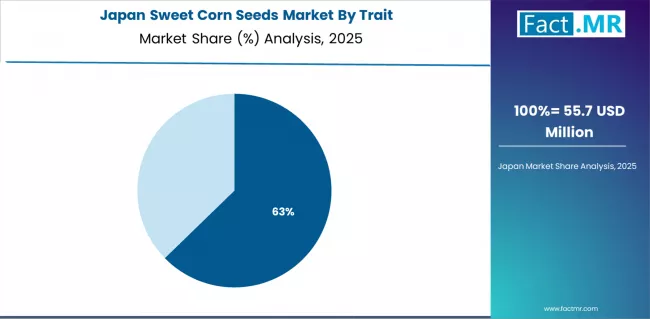
Japan's market expansion benefits from precision agricultural demand, including advanced crop varieties in Hokkaido and Tohoku, agricultural facility modernization, and farming technology programs that increasingly incorporate sweet corn seeds for agricultural optimization applications. The country maintains a 3.7% growth rate, driven by agricultural technology advancement and increasing recognition of seed variety benefits, including precise crop control and comprehensive farming enhancement.
Market dynamics focus on high-precision agricultural solutions that balance advanced performance with quality considerations important to Japanese farmers. Growing agricultural technology integration creates continued demand for sophisticated seed varieties in farming infrastructure and agricultural modernization projects.
Market Intelligence Brief:
- Agricultural technology and farming segments leading growth with focus on precision varieties and crop optimization applications
- Regional agricultural requirements driving diverse seed portfolio from basic varieties to advanced agricultural systems
- Technology advancement emphasis on precision breeding and agricultural control systems
- Government agricultural initiatives supporting domestic farming capabilities and technological competitiveness
South Korea Drives Agricultural Innovation
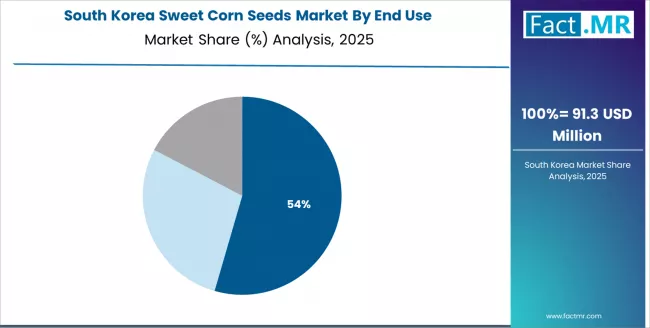
South Korea establishes strong market position through agricultural innovation programs and farming modernization expansion, integrating advanced sweet corn seeds as standard components for crop enhancement and agricultural optimization applications. The country's 3.9% growth rate reflects government agricultural initiatives and farming modernization programs that emphasize advanced seed systems for agricultural enhancement and crop optimization. Growth concentrates in major agricultural centers, including Gyeonggi and Jeolla provinces, where farming development showcases integrated seed systems that appeal to farmers seeking comprehensive agricultural capabilities and crop optimization applications.
Korean agricultural companies are developing innovative seed solutions that combine domestic breeding innovation advantages with advanced agricultural features, including farming system integration and enhanced crop capabilities. Distribution channels through agricultural cooperatives and farming suppliers expand market access, while government support for agricultural innovation supports adoption across crop production and farming segments.
Strategic Market Indicators:
- Agricultural innovation facilities leading adoption with 68% deployment rate in farming and crop production sectors
- Government agricultural programs providing substantial funding for domestic farming advancement
- Local agricultural companies capturing significant market share through innovation leadership and farming integration expertise
- Export market development for advanced seed solutions targeting regional agricultural markets
Mexico Shows Agricultural Expansion
Mexico's market expansion benefits from growing agricultural modernization, including farming system development in Sinaloa and Jalisco, agricultural facility upgrades, and food production programs that increasingly incorporate sweet corn seed solutions for crop optimization applications. The country maintains a 4.5% growth rate, driven by agricultural industry growth and increasing adoption of advanced farming solutions, including sophisticated seed technology and crop production enhancement.
Market dynamics focus on accessible seed solutions that balance performance with affordability considerations important to Mexican farmers and agricultural producers. Growing agricultural modernization creates continued demand for reliable seed varieties in farming expansion and crop production improvement projects.
Strategic Market Considerations:
- Agricultural expansion segments leading growth with focus on accessibility and crop optimization applications
- Regional farming requirements driving diverse seed portfolio from basic varieties to premium agricultural systems
- Import considerations balanced by potential domestic agricultural partnerships with international seed providers
- Government agricultural initiatives influencing farming standards and crop production requirements
Europe Market Split by Country
The Europe sweet corn seeds market is projected to grow from USD 520.0 million in 2025 to USD 785.0 million by 2035, registering a CAGR of 4.2% over the forecast period. Germany is expected to maintain its leadership position with a 28.5% market share in 2025, supported by its advanced agricultural infrastructure and major farming centers.
United Kingdom follows with a 24.2% share in 2025, driven by comprehensive specialty agriculture programs and sustainable farming initiatives. France holds a 22.8% share through specialized crop applications and agricultural innovation requirements. Italy commands a 13.1% share, while Spain accounts for 8.6% in 2025. The Rest of Western Europe region is anticipated to gain momentum, expanding its collective share from 2.8% to 3.3% by 2035, attributed to increasing agricultural investment in Nordic countries and emerging farming facilities implementing seed technology advancement programs.
Hybrid Varieties Dominate Agricultural Applications in Germany
In Germany, the sweet corn seeds market prioritizes hybrid varieties, which capture the dominant 64% share of agricultural and farming installations due to their advanced features, including precision breeding mechanisms and seamless integration with existing agricultural infrastructure. German farming operators emphasize performance, sustainability compliance, and long-term agricultural reliability, creating demand for hybrid seed systems that provide consistent crop capabilities and adaptive performance based on farming requirements and environmental conditions. Other trait categories maintain secondary positions primarily in specialized applications and organic farming facilities where comprehensive agricultural functionality meets farming requirements without compromising sustainability effectiveness.
Market Characteristics:
- Premium focus on hybrid varieties with advanced breeding technology and precision agricultural capabilities
- Integration requirements with existing farming platforms and agricultural management systems
- Emphasis on crop outcome optimization and long-term agricultural reliability in farming applications
Seed Companies Lead Variety Development in United Kingdom
In United Kingdom, the market structure favors international seed companies, including Bayer, Corteva, and Syngenta, which maintain dominant positions through comprehensive seed portfolios and established agricultural networks supporting both conventional and specialty farming installations. These providers offer integrated solutions combining advanced seed varieties with professional agronomic services and ongoing farming support that appeal to British farmers seeking reliable agricultural systems. Local agricultural contractors and specialty distributors capture a moderate market share by providing localized farming support capabilities and competitive pricing for standard seed installations, while domestic companies focus on specialized applications and premium solutions tailored to British agricultural characteristics.
Channel Insights:
- International seed brands maintaining premium market positioning through advanced variety offerings
- Local agricultural service networks expanding to support growing demand for professional agronomic consultation and farming support
- Agricultural integration capabilities becoming a key differentiator for farm-wide and crop production applications
Competitive Landscape of the Sweet Corn Seeds Market
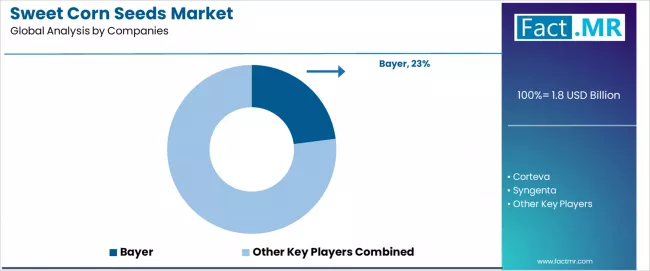
- Structure: ~15-20 credible players; top 3-5 hold ~50-55% by revenue.
- Leadership is maintained through: breeding innovation, agricultural expertise, and distribution networks.
- What's commoditizing: basic hybrid varieties and standard agricultural traits.
- Margin Opportunities: specialty genetics, precision agriculture services, and farmer support programs.
| Stakeholder | What they actually control | Typical strengths | Typical blind spots |
|---|---|---|---|
| Global seed leaders | R&D capabilities, breeding programs, distribution reach | Innovation leadership, comprehensive portfolios, market access | Local adaptation; smallholder markets |
| Regional specialists | Local genetics, farmer relationships, regional expertise | Market knowledge, farmer trust, adaptation focus | Scale limitations; technology gaps |
| Agricultural cooperatives | Farmer networks, local distribution, community trust | Farmer relationships, affordability focus | Innovation capacity; breeding expertise |
| Specialty breeders | Niche genetics, organic varieties, specialty traits | Specialized expertise, premium positioning | Limited scale; distribution challenges |
Key Players in the Sweet Corn Seeds Market
- Bayer
- Corteva
- Syngenta
- Limagrain
- Sakata
- Takii
- East-West Seed
- KWS
- Rijk Zwaan
- Advanta
Scope of the Report
| Item | Value |
|---|---|
| Quantitative Units | USD 1.8 billion |
| Trait | Hybrid, Open-pollinated |
| End Use | Food, Fodder, Industrial/Others |
| Distribution | Agri-retailers, Cooperatives, Online/Others |
| Application | Fresh Market Production, Processing, Livestock Feed, Specialty Farming |
| Regions Covered | North America, Western Europe, East Asia, South Asia Pacific, Latin America, Middle East & Africa |
| Countries Covered | United States, Germany, United Kingdom, France, Japan, South Korea, Mexico, Canada, Italy, and 25+ additional countries |
| Key Companies Profiled | Bayer, Corteva, Syngenta, Limagrain, Sakata, Takii, East-West Seed, KWS, Rijk Zwaan, Advanta |
| Additional Attributes | Dollar sales by trait and end use categories, regional adoption trends across North America, Western Europe, and East Asia, competitive landscape with seed manufacturers and agricultural technology providers, farmer preferences for yield optimization and crop reliability, integration with agricultural platforms and farm management systems, innovations in breeding technology and genetic enhancement, and development of climate-adapted varieties with enhanced performance and agricultural optimization capabilities. |
Sweet Corn Seeds Market by Segments
-
Trait:
- Hybrid
- Open-pollinated
-
End Use:
- Food
- Fodder
- Industrial/Others
-
Distribution:
- Agri-retailers
- Cooperatives
- Online/Others
-
Application:
- Fresh Market Production
- Processing
- Livestock Feed
- Specialty Farming
-
Region:
- North America
- United States
- Canada
- Mexico
- Western Europe
- Germany
- United Kingdom
- France
- Italy
- Spain
- Nordic
- BENELUX
- Rest of Western Europe
- East Asia
- China
- Japan
- South Korea
- South Asia Pacific
- India
- ASEAN
- Australia & New Zealand
- Rest of South Asia Pacific
- Latin America
- Brazil
- Chile
- Rest of Latin America
- Middle East & Africa
- Kingdom of Saudi Arabia
- Other GCC Countries
- Turkey
- South Africa
- Other African Union
- Rest of Middle East & Africa
- North America
Table of Content
- Executive Summary
- Global Market Outlook
- Demand to side Trends
- Supply to side Trends
- Technology Roadmap Analysis
- Analysis and Recommendations
- Market Overview
- Market Coverage / Taxonomy
- Market Definition / Scope / Limitations
- Market Background
- Market Dynamics
- Drivers
- Restraints
- Opportunity
- Trends
- Scenario Forecast
- Demand in Optimistic Scenario
- Demand in Likely Scenario
- Demand in Conservative Scenario
- Opportunity Map Analysis
- Product Life Cycle Analysis
- Supply Chain Analysis
- Investment Feasibility Matrix
- Value Chain Analysis
- PESTLE and Porter’s Analysis
- Regulatory Landscape
- Regional Parent Market Outlook
- Production and Consumption Statistics
- Import and Export Statistics
- Market Dynamics
- Global Market Analysis 2020 to 2024 and Forecast, 2025 to 2035
- Historical Market Size Value (USD Million) Analysis, 2020 to 2024
- Current and Future Market Size Value (USD Million) Projections, 2025 to 2035
- Y to o to Y Growth Trend Analysis
- Absolute $ Opportunity Analysis
- Global Market Pricing Analysis 2020 to 2024 and Forecast 2025 to 2035
- Global Market Analysis 2020 to 2024 and Forecast 2025 to 2035, By Trait
- Introduction / Key Findings
- Historical Market Size Value (USD Million) Analysis By Trait , 2020 to 2024
- Current and Future Market Size Value (USD Million) Analysis and Forecast By Trait , 2025 to 2035
- Hybrid
- Open-pollinated
- Y to o to Y Growth Trend Analysis By Trait , 2020 to 2024
- Absolute $ Opportunity Analysis By Trait , 2025 to 2035
- Global Market Analysis 2020 to 2024 and Forecast 2025 to 2035, By End Use
- Introduction / Key Findings
- Historical Market Size Value (USD Million) Analysis By End Use, 2020 to 2024
- Current and Future Market Size Value (USD Million) Analysis and Forecast By End Use, 2025 to 2035
- Food
- Fodder
- Industrial/Others
- Y to o to Y Growth Trend Analysis By End Use, 2020 to 2024
- Absolute $ Opportunity Analysis By End Use, 2025 to 2035
- Global Market Analysis 2020 to 2024 and Forecast 2025 to 2035, By Distribution
- Introduction / Key Findings
- Historical Market Size Value (USD Million) Analysis By Distribution, 2020 to 2024
- Current and Future Market Size Value (USD Million) Analysis and Forecast By Distribution, 2025 to 2035
- Agri-retailers
- Cooperatives
- Online/Others
- Y to o to Y Growth Trend Analysis By Distribution, 2020 to 2024
- Absolute $ Opportunity Analysis By Distribution, 2025 to 2035
- Global Market Analysis 2020 to 2024 and Forecast 2025 to 2035, By Region
- Introduction
- Historical Market Size Value (USD Million) Analysis By Region, 2020 to 2024
- Current Market Size Value (USD Million) Analysis and Forecast By Region, 2025 to 2035
- North America
- Latin America
- Western Europe
- Eastern Europe
- East Asia
- South Asia and Pacific
- Middle East & Africa
- Market Attractiveness Analysis By Region
- North America Market Analysis 2020 to 2024 and Forecast 2025 to 2035, By Country
- Historical Market Size Value (USD Million) Trend Analysis By Market Taxonomy, 2020 to 2024
- Market Size Value (USD Million) Forecast By Market Taxonomy, 2025 to 2035
- By Country
- USA
- Canada
- Mexico
- By Trait
- By End Use
- By Distribution
- By Country
- Market Attractiveness Analysis
- By Country
- By Trait
- By End Use
- By Distribution
- Key Takeaways
- Latin America Market Analysis 2020 to 2024 and Forecast 2025 to 2035, By Country
- Historical Market Size Value (USD Million) Trend Analysis By Market Taxonomy, 2020 to 2024
- Market Size Value (USD Million) Forecast By Market Taxonomy, 2025 to 2035
- By Country
- Brazil
- Chile
- Rest of Latin America
- By Trait
- By End Use
- By Distribution
- By Country
- Market Attractiveness Analysis
- By Country
- By Trait
- By End Use
- By Distribution
- Key Takeaways
- Western Europe Market Analysis 2020 to 2024 and Forecast 2025 to 2035, By Country
- Historical Market Size Value (USD Million) Trend Analysis By Market Taxonomy, 2020 to 2024
- Market Size Value (USD Million) Forecast By Market Taxonomy, 2025 to 2035
- By Country
- Germany
- UK
- Italy
- Spain
- France
- Nordic
- BENELUX
- Rest of Western Europe
- By Trait
- By End Use
- By Distribution
- By Country
- Market Attractiveness Analysis
- By Country
- By Trait
- By End Use
- By Distribution
- Key Takeaways
- Eastern Europe Market Analysis 2020 to 2024 and Forecast 2025 to 2035, By Country
- Historical Market Size Value (USD Million) Trend Analysis By Market Taxonomy, 2020 to 2024
- Market Size Value (USD Million) Forecast By Market Taxonomy, 2025 to 2035
- By Country
- Russia
- Poland
- Hungary
- Balkan & Baltic
- Rest of Eastern Europe
- By Trait
- By End Use
- By Distribution
- By Country
- Market Attractiveness Analysis
- By Country
- By Trait
- By End Use
- By Distribution
- Key Takeaways
- East Asia Market Analysis 2020 to 2024 and Forecast 2025 to 2035, By Country
- Historical Market Size Value (USD Million) Trend Analysis By Market Taxonomy, 2020 to 2024
- Market Size Value (USD Million) Forecast By Market Taxonomy, 2025 to 2035
- By Country
- China
- Japan
- South Korea
- By Trait
- By End Use
- By Distribution
- By Country
- Market Attractiveness Analysis
- By Country
- By Trait
- By End Use
- By Distribution
- Key Takeaways
- South Asia and Pacific Market Analysis 2020 to 2024 and Forecast 2025 to 2035, By Country
- Historical Market Size Value (USD Million) Trend Analysis By Market Taxonomy, 2020 to 2024
- Market Size Value (USD Million) Forecast By Market Taxonomy, 2025 to 2035
- By Country
- India
- ASEAN
- Australia & New Zealand
- Rest of South Asia and Pacific
- By Trait
- By End Use
- By Distribution
- By Country
- Market Attractiveness Analysis
- By Country
- By Trait
- By End Use
- By Distribution
- Key Takeaways
- Middle East & Africa Market Analysis 2020 to 2024 and Forecast 2025 to 2035, By Country
- Historical Market Size Value (USD Million) Trend Analysis By Market Taxonomy, 2020 to 2024
- Market Size Value (USD Million) Forecast By Market Taxonomy, 2025 to 2035
- By Country
- Kingdom of Saudi Arabia
- Other GCC Countries
- Turkiye
- South Africa
- Other African Union
- Rest of Middle East & Africa
- By Trait
- By End Use
- By Distribution
- By Country
- Market Attractiveness Analysis
- By Country
- By Trait
- By End Use
- By Distribution
- Key Takeaways
- Key Countries Market Analysis
- USA
- Pricing Analysis
- Market Share Analysis, 2024
- By Trait
- By End Use
- By Distribution
- Canada
- Pricing Analysis
- Market Share Analysis, 2024
- By Trait
- By End Use
- By Distribution
- Mexico
- Pricing Analysis
- Market Share Analysis, 2024
- By Trait
- By End Use
- By Distribution
- Brazil
- Pricing Analysis
- Market Share Analysis, 2024
- By Trait
- By End Use
- By Distribution
- Chile
- Pricing Analysis
- Market Share Analysis, 2024
- By Trait
- By End Use
- By Distribution
- Germany
- Pricing Analysis
- Market Share Analysis, 2024
- By Trait
- By End Use
- By Distribution
- UK
- Pricing Analysis
- Market Share Analysis, 2024
- By Trait
- By End Use
- By Distribution
- Italy
- Pricing Analysis
- Market Share Analysis, 2024
- By Trait
- By End Use
- By Distribution
- Spain
- Pricing Analysis
- Market Share Analysis, 2024
- By Trait
- By End Use
- By Distribution
- France
- Pricing Analysis
- Market Share Analysis, 2024
- By Trait
- By End Use
- By Distribution
- India
- Pricing Analysis
- Market Share Analysis, 2024
- By Trait
- By End Use
- By Distribution
- ASEAN
- Pricing Analysis
- Market Share Analysis, 2024
- By Trait
- By End Use
- By Distribution
- Australia & New Zealand
- Pricing Analysis
- Market Share Analysis, 2024
- By Trait
- By End Use
- By Distribution
- China
- Pricing Analysis
- Market Share Analysis, 2024
- By Trait
- By End Use
- By Distribution
- Japan
- Pricing Analysis
- Market Share Analysis, 2024
- By Trait
- By End Use
- By Distribution
- South Korea
- Pricing Analysis
- Market Share Analysis, 2024
- By Trait
- By End Use
- By Distribution
- Russia
- Pricing Analysis
- Market Share Analysis, 2024
- By Trait
- By End Use
- By Distribution
- Poland
- Pricing Analysis
- Market Share Analysis, 2024
- By Trait
- By End Use
- By Distribution
- Hungary
- Pricing Analysis
- Market Share Analysis, 2024
- By Trait
- By End Use
- By Distribution
- Kingdom of Saudi Arabia
- Pricing Analysis
- Market Share Analysis, 2024
- By Trait
- By End Use
- By Distribution
- Turkiye
- Pricing Analysis
- Market Share Analysis, 2024
- By Trait
- By End Use
- By Distribution
- South Africa
- Pricing Analysis
- Market Share Analysis, 2024
- By Trait
- By End Use
- By Distribution
- USA
- Market Structure Analysis
- Competition Dashboard
- Competition Benchmarking
- Market Share Analysis of Top Players
- By Regional
- By Trait
- By End Use
- By Distribution
- Competition Analysis
- Competition Deep Dive
- Bayer
- Overview
- Product Portfolio
- Profitability by Market Segments (Product/Age /Sales Channel/Region)
- Sales Footprint
- Strategy Overview
- Marketing Strategy
- Product Strategy
- Channel Strategy
- Corteva
- Syngenta
- Limagrain
- Sakata
- Takii
- East-West Seed
- KWS
- Rijk Zwaan
- Advanta
- Bayer
- Competition Deep Dive
- Assumptions & Acronyms Used
- Research Methodology
List Of Table
- Table 1: Global Market Value (USD Million) Forecast by Region, 2020 to 2035
- Table 2: Global Market Value (USD Million) Forecast by Trait , 2020 to 2035
- Table 3: Global Market Value (USD Million) Forecast by End Use, 2020 to 2035
- Table 4: Global Market Value (USD Million) Forecast by Distribution, 2020 to 2035
- Table 5: North America Market Value (USD Million) Forecast by Country, 2020 to 2035
- Table 6: North America Market Value (USD Million) Forecast by Trait , 2020 to 2035
- Table 7: North America Market Value (USD Million) Forecast by End Use, 2020 to 2035
- Table 8: North America Market Value (USD Million) Forecast by Distribution, 2020 to 2035
- Table 9: Latin America Market Value (USD Million) Forecast by Country, 2020 to 2035
- Table 10: Latin America Market Value (USD Million) Forecast by Trait , 2020 to 2035
- Table 11: Latin America Market Value (USD Million) Forecast by End Use, 2020 to 2035
- Table 12: Latin America Market Value (USD Million) Forecast by Distribution, 2020 to 2035
- Table 13: Western Europe Market Value (USD Million) Forecast by Country, 2020 to 2035
- Table 14: Western Europe Market Value (USD Million) Forecast by Trait , 2020 to 2035
- Table 15: Western Europe Market Value (USD Million) Forecast by End Use, 2020 to 2035
- Table 16: Western Europe Market Value (USD Million) Forecast by Distribution, 2020 to 2035
- Table 17: Eastern Europe Market Value (USD Million) Forecast by Country, 2020 to 2035
- Table 18: Eastern Europe Market Value (USD Million) Forecast by Trait , 2020 to 2035
- Table 19: Eastern Europe Market Value (USD Million) Forecast by End Use, 2020 to 2035
- Table 20: Eastern Europe Market Value (USD Million) Forecast by Distribution, 2020 to 2035
- Table 21: East Asia Market Value (USD Million) Forecast by Country, 2020 to 2035
- Table 22: East Asia Market Value (USD Million) Forecast by Trait , 2020 to 2035
- Table 23: East Asia Market Value (USD Million) Forecast by End Use, 2020 to 2035
- Table 24: East Asia Market Value (USD Million) Forecast by Distribution, 2020 to 2035
- Table 25: South Asia and Pacific Market Value (USD Million) Forecast by Country, 2020 to 2035
- Table 26: South Asia and Pacific Market Value (USD Million) Forecast by Trait , 2020 to 2035
- Table 27: South Asia and Pacific Market Value (USD Million) Forecast by End Use, 2020 to 2035
- Table 28: South Asia and Pacific Market Value (USD Million) Forecast by Distribution, 2020 to 2035
- Table 29: Middle East & Africa Market Value (USD Million) Forecast by Country, 2020 to 2035
- Table 30: Middle East & Africa Market Value (USD Million) Forecast by Trait , 2020 to 2035
- Table 31: Middle East & Africa Market Value (USD Million) Forecast by End Use, 2020 to 2035
- Table 32: Middle East & Africa Market Value (USD Million) Forecast by Distribution, 2020 to 2035
List Of Figures
- Figure 1: Global Market Pricing Analysis
- Figure 2: Global Market Value (USD Million) Forecast 2020-2035
- Figure 3: Global Market Value Share and BPS Analysis by Trait , 2025 and 2035
- Figure 4: Global Market Y to o to Y Growth Comparison by Trait , 2025-2035
- Figure 5: Global Market Attractiveness Analysis by Trait
- Figure 6: Global Market Value Share and BPS Analysis by End Use, 2025 and 2035
- Figure 7: Global Market Y to o to Y Growth Comparison by End Use, 2025-2035
- Figure 8: Global Market Attractiveness Analysis by End Use
- Figure 9: Global Market Value Share and BPS Analysis by Distribution, 2025 and 2035
- Figure 10: Global Market Y to o to Y Growth Comparison by Distribution, 2025-2035
- Figure 11: Global Market Attractiveness Analysis by Distribution
- Figure 12: Global Market Value (USD Million) Share and BPS Analysis by Region, 2025 and 2035
- Figure 13: Global Market Y to o to Y Growth Comparison by Region, 2025-2035
- Figure 14: Global Market Attractiveness Analysis by Region
- Figure 15: North America Market Incremental Dollar Opportunity, 2025-2035
- Figure 16: Latin America Market Incremental Dollar Opportunity, 2025-2035
- Figure 17: Western Europe Market Incremental Dollar Opportunity, 2025-2035
- Figure 18: Eastern Europe Market Incremental Dollar Opportunity, 2025-2035
- Figure 19: East Asia Market Incremental Dollar Opportunity, 2025-2035
- Figure 20: South Asia and Pacific Market Incremental Dollar Opportunity, 2025-2035
- Figure 21: Middle East & Africa Market Incremental Dollar Opportunity, 2025-2035
- Figure 22: North America Market Value Share and BPS Analysis by Country, 2025 and 2035
- Figure 23: North America Market Value Share and BPS Analysis by Trait , 2025 and 2035
- Figure 24: North America Market Y to o to Y Growth Comparison by Trait , 2025-2035
- Figure 25: North America Market Attractiveness Analysis by Trait
- Figure 26: North America Market Value Share and BPS Analysis by End Use, 2025 and 2035
- Figure 27: North America Market Y to o to Y Growth Comparison by End Use, 2025-2035
- Figure 28: North America Market Attractiveness Analysis by End Use
- Figure 29: North America Market Value Share and BPS Analysis by Distribution, 2025 and 2035
- Figure 30: North America Market Y to o to Y Growth Comparison by Distribution, 2025-2035
- Figure 31: North America Market Attractiveness Analysis by Distribution
- Figure 32: Latin America Market Value Share and BPS Analysis by Country, 2025 and 2035
- Figure 33: Latin America Market Value Share and BPS Analysis by Trait , 2025 and 2035
- Figure 34: Latin America Market Y to o to Y Growth Comparison by Trait , 2025-2035
- Figure 35: Latin America Market Attractiveness Analysis by Trait
- Figure 36: Latin America Market Value Share and BPS Analysis by End Use, 2025 and 2035
- Figure 37: Latin America Market Y to o to Y Growth Comparison by End Use, 2025-2035
- Figure 38: Latin America Market Attractiveness Analysis by End Use
- Figure 39: Latin America Market Value Share and BPS Analysis by Distribution, 2025 and 2035
- Figure 40: Latin America Market Y to o to Y Growth Comparison by Distribution, 2025-2035
- Figure 41: Latin America Market Attractiveness Analysis by Distribution
- Figure 42: Western Europe Market Value Share and BPS Analysis by Country, 2025 and 2035
- Figure 43: Western Europe Market Value Share and BPS Analysis by Trait , 2025 and 2035
- Figure 44: Western Europe Market Y to o to Y Growth Comparison by Trait , 2025-2035
- Figure 45: Western Europe Market Attractiveness Analysis by Trait
- Figure 46: Western Europe Market Value Share and BPS Analysis by End Use, 2025 and 2035
- Figure 47: Western Europe Market Y to o to Y Growth Comparison by End Use, 2025-2035
- Figure 48: Western Europe Market Attractiveness Analysis by End Use
- Figure 49: Western Europe Market Value Share and BPS Analysis by Distribution, 2025 and 2035
- Figure 50: Western Europe Market Y to o to Y Growth Comparison by Distribution, 2025-2035
- Figure 51: Western Europe Market Attractiveness Analysis by Distribution
- Figure 52: Eastern Europe Market Value Share and BPS Analysis by Country, 2025 and 2035
- Figure 53: Eastern Europe Market Value Share and BPS Analysis by Trait , 2025 and 2035
- Figure 54: Eastern Europe Market Y to o to Y Growth Comparison by Trait , 2025-2035
- Figure 55: Eastern Europe Market Attractiveness Analysis by Trait
- Figure 56: Eastern Europe Market Value Share and BPS Analysis by End Use, 2025 and 2035
- Figure 57: Eastern Europe Market Y to o to Y Growth Comparison by End Use, 2025-2035
- Figure 58: Eastern Europe Market Attractiveness Analysis by End Use
- Figure 59: Eastern Europe Market Value Share and BPS Analysis by Distribution, 2025 and 2035
- Figure 60: Eastern Europe Market Y to o to Y Growth Comparison by Distribution, 2025-2035
- Figure 61: Eastern Europe Market Attractiveness Analysis by Distribution
- Figure 62: East Asia Market Value Share and BPS Analysis by Country, 2025 and 2035
- Figure 63: East Asia Market Value Share and BPS Analysis by Trait , 2025 and 2035
- Figure 64: East Asia Market Y to o to Y Growth Comparison by Trait , 2025-2035
- Figure 65: East Asia Market Attractiveness Analysis by Trait
- Figure 66: East Asia Market Value Share and BPS Analysis by End Use, 2025 and 2035
- Figure 67: East Asia Market Y to o to Y Growth Comparison by End Use, 2025-2035
- Figure 68: East Asia Market Attractiveness Analysis by End Use
- Figure 69: East Asia Market Value Share and BPS Analysis by Distribution, 2025 and 2035
- Figure 70: East Asia Market Y to o to Y Growth Comparison by Distribution, 2025-2035
- Figure 71: East Asia Market Attractiveness Analysis by Distribution
- Figure 72: South Asia and Pacific Market Value Share and BPS Analysis by Country, 2025 and 2035
- Figure 73: South Asia and Pacific Market Value Share and BPS Analysis by Trait , 2025 and 2035
- Figure 74: South Asia and Pacific Market Y to o to Y Growth Comparison by Trait , 2025-2035
- Figure 75: South Asia and Pacific Market Attractiveness Analysis by Trait
- Figure 76: South Asia and Pacific Market Value Share and BPS Analysis by End Use, 2025 and 2035
- Figure 77: South Asia and Pacific Market Y to o to Y Growth Comparison by End Use, 2025-2035
- Figure 78: South Asia and Pacific Market Attractiveness Analysis by End Use
- Figure 79: South Asia and Pacific Market Value Share and BPS Analysis by Distribution, 2025 and 2035
- Figure 80: South Asia and Pacific Market Y to o to Y Growth Comparison by Distribution, 2025-2035
- Figure 81: South Asia and Pacific Market Attractiveness Analysis by Distribution
- Figure 82: Middle East & Africa Market Value Share and BPS Analysis by Country, 2025 and 2035
- Figure 83: Middle East & Africa Market Value Share and BPS Analysis by Trait , 2025 and 2035
- Figure 84: Middle East & Africa Market Y to o to Y Growth Comparison by Trait , 2025-2035
- Figure 85: Middle East & Africa Market Attractiveness Analysis by Trait
- Figure 86: Middle East & Africa Market Value Share and BPS Analysis by End Use, 2025 and 2035
- Figure 87: Middle East & Africa Market Y to o to Y Growth Comparison by End Use, 2025-2035
- Figure 88: Middle East & Africa Market Attractiveness Analysis by End Use
- Figure 89: Middle East & Africa Market Value Share and BPS Analysis by Distribution, 2025 and 2035
- Figure 90: Middle East & Africa Market Y to o to Y Growth Comparison by Distribution, 2025-2035
- Figure 91: Middle East & Africa Market Attractiveness Analysis by Distribution
- Figure 92: Global Market - Tier Structure Analysis
- Figure 93: Global Market - Company Share Analysis
- FAQs -
How big is the sweet corn seeds market in 2025?
The global sweet corn seeds market is estimated to be valued at USD 1.8 billion in 2025.
What will be the size of sweet corn seeds market in 2035?
The market size for the sweet corn seeds market is projected to reach USD 2.8 billion by 2035.
How much will be the sweet corn seeds market growth between 2025 and 2035?
The sweet corn seeds market is expected to grow at a 4.5% CAGR between 2025 and 2035.
What are the key product types in the sweet corn seeds market?
The key product types in sweet corn seeds market are hybrid and open-pollinated.
Which end use segment to contribute significant share in the sweet corn seeds market in 2025?
In terms of end use, food segment to command 54.0% share in the sweet corn seeds market in 2025.